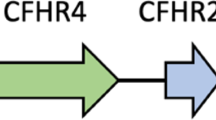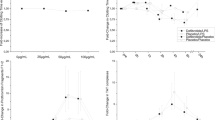Abstract
Hepatic veno-occlusive disease (VOD) is a life-threatening complication after stem cell transplantation (SCT), characterized by thrombus formation in hepatic venules leading to a symptom triad of hyperbilirubinemia, hepatomegaly, and ascites. Multifactorial defects in the hemostatic system may contribute to its pathogenesis, but its remains to be investigated. Unusually large VWF multimers (UL-VWFMs), produced in and released from vascular endothelial cells, are most biologically active in the interaction with platelets under a high shear stress. UL-VWFMs are cleaved and degraded into smaller VWFMs by a specific liver producing plasma protease, termed VWF-cleaving protease (VWF-CPase), which has recently been identified as a metalloprotease solely produced in liver, termed ADAMTS13. Herein, we studied the correlation between plasma VWF-CPase activity and UL-VWFMs in 21 patients who received SCT, seven patients with VOD and 14 patients without VOD. In non-VOD patients, activities (mean ± 1s.d.) of VWF-CPase were 78 ± 17% of the control before the conditioning regimen, 76 ± 18% on day 0, 64 ± 19% on day 7, 57 ± 23% on day 14, 68 ± 13% on day 21 and 79 ± 19% on day 28 after SCT. The respective values in VOD patients were 32 ± 19%, 27 ± 15%, 18 ± 11%, 22 ± 18%, 26 ± 22% and 12 ± 4%. Thus, VWF-CPase activity was significantly reduced in VOD patients, even before the conditioning regimen, and such a difference was not found in other laboratory tests. However, despite such a clear difference, UL-VWFMs were present in plasmas of both patient groups, together with the increase of VWF antigen and ristocetin cofactor activity. These results indicate that the measurement of this enzyme activity is extremely useful in predicting the occurrence of VOD prior to a demonstration of its direct involvement in its pathogenesis.
This is a preview of subscription content, access via your institution
Access options
Subscribe to this journal
Receive 12 print issues and online access
$259.00 per year
only $21.58 per issue
Buy this article
- Purchase on Springer Link
- Instant access to full article PDF
Prices may be subject to local taxes which are calculated during checkout


Similar content being viewed by others
References
McDonald GB, Sharma P, Matthews DE et al. Veno-occlusive disease of the liver after bone marrow transplantation: diagnosis, incidence, and predisposing factors Hepatology 1984 4: 116 122
McDonald GB, Sharma P, Matthews DE et al. The clinical course of 53 patients with veno-occlusive disease of the liver after marrow transplantation Transplantation 1985 39: 603 608
Shulman HM, Gown AM, Nugent DJ . Hepatic veno-occlusive disease after marrow transplantation Am J Pathol 1987 127: 549 558
Jones RJ, Lee KSK, Beschorner WF et al. Veno-occlusive disease of the liver following bone marrow transplantation Transplantation 1987 44: 778 783
Shulman HM, Hinterberger W . Hepatic veno-occlusive disease: liver toxicity syndrome after bone marrow transplantation Bone Marrow Transplant 1992 10: 197 214
Bearman SI . The syndrome of hepatic veno-occlusive disease after marrow transplantation Blood 1995 85: 3005 3020
Ruggeri ZM, Ware J . von Willebrand factor FASEB J 1993 7: 308 316
Fujimura Y, Titani K . Structure and function of von Willebrand factor. In: Bloom AL, Forbes CD, Thomas DP, Tuddenham EGD (eds) Haemostasis and Thrombosis Churchill Livingstone: London 1987 379 395
Collins PW, Gutterridge CN, O'Driscoll A et al. von Willebrand factor as a marker of endothelial cell activation following BMT Bone Marrow Transplant 1992 10: 499 506
Park Y-D, Yasui M, Yoshimoto T et al. Changes in hemostatic parameters in hepatic veno-occlusive disease following bone marrow transplantation Bone Marrow Transplant 1997 19: 915 920
Matsui T, Shimoyama T, Matsumoto M et al. ABO blood group antigens on human von Willebrand factor after ABO-mismatched bone marrow transplantation Blood 1999 94: 2895 2900
Moschcowitz E . Hyaline thrombosis of the terminal arterioles and capillaries: a hitherto undescribed disease Proc NY Pathol Soc 1924 24: 21 24
Moake JL, Turnur NA, Stathopoulos NA et al. Involvement of large von Willebrand factor (vWF) multimers and unusually large vWF forms derived from endothelial cells in shear stress-induced platelet aggregation J Clin Invest 1986 78: 1456 1461
Fujimura Y, Matsumoto M, Yagi H et al. von Willebrand factor-cleaving protease and Upshaw–Schulman syndrome. Progress in Hematology Int J Hematol 2002 75: 25 34
Tsai H-M . Physiological cleavage of von Willebrand factor by a plasma protease is dependent on its conformation and requires calcium ion Blood 1996 87: 4235 4244
Furlan M, Robles R, Lämmle B . Partial purification and characterization of protease from human plasma cleaving von Willebrand factor to fragments produced by in vivo proteolysis Blood 1996 87: 4223 4234
Gerritsen H, Robles R, Lämmle B, Furlan M . Partial amino acid sequence of purified von Willebrand factor-cleaving protease Blood 2001 98: 1654 1661
Fujikawa K, Suzuki H, McMullen B, Chung D . Purification of human von Willebrand factor-cleaving protease and its identification as a new member of the metalloproteinase family Blood 2001 98: 1662 1666
Zheng X, Chung D, Takayama TK et al. Structure of von Willebrand factor-cleaving protease (ADAMTS13), a metalloprotease involved in thrombotic thrombocytopenic purpura J Biol Chem 2001 276: 41089 41163
Soejima K, Mimura N, Hirashima M et al. A novel human metalloprotease synthesized in the liver and secreted into the blood: Possibly, the von Willebrand factor-cleaving protease? J Biochem 2001 130: 475 480
Bartlett A, Dormand KM, Hawkey CM et al. Factor VIII-related antigen: measurement by enzyme immunoassay Br Med J 1976 24: 994 996
Macfarlane DE, Stibbe J, Kirby EP et al. A method for assaying von Willebrand factor (ristocetin cofactor) Thromb Diath Haemorrh 1975 34: 306 308
Ruggeri ZM, Zimmerman TS . The complex multimetric composition of factor VIII/von Willebrand factor Blood 1981 57: 1140 1143
Budde U, Schneppenheim R, Plendl H et al. Luminographic detection of von Willebrand factor multimers in agarose gels and on nitrocellulose membranes Thromb Haemost 1990 63: 312 315
Furlan M, Robles R, Solenthal M et al. Deficient activity of von Willebrand factor-cleaving protease in chronic relapsing thrombotic thrombocytopenic purpura Blood 1997 89: 3097 3103
Kinoshita S, Yoshioka A, Park Y-D et al. Upshaw–Schulman syndrome revisited: a concept of congenital thrombotic thrombocytopenic purpura Int J Hematol 2001 74: 101 108
Yagi H, Konno M, Kinoshita S et al. Plasma of patients with Upshaw–Schulman syndrome, a congenital deficiency of von Willebrand factor-cleaving protease, enhances the aggregation of normal washed platelets under high shear stress Br J Haematol 2001 115: 991 997
Mori Y, Wada H, Gabazza EC et al. von Willebrand factor-cleaving protease activity predicts response to plasma exchange in patients with TTP Transfusion 2002 (in press)
Furlan M, Robleb R, Galbusera M et al. von Willebrand factor-cleaving protease in thrombotic thrombocytopenic purpura and the hemolytic-uremic syndrome New Engl J Med 1998 339: 1578 1584
Tsai H-M, Lian ECY . Antibodies to von Willebrand factor-cleaving protease in acute thrombotic thrombocytopenic purpura New Engl J Med 1998 339: 1585 1594
Kasper CK, Aledort LM, Counts RB et al. A more uniform measurement of factor VIII inhibitors Thromb Diath Haemorrh 1975 34: 869 872
Attal M, Huguet F, Rubie H et al. Prevention of hepatic veno-occlusive disease after bone marrow transplantation by continuous infusion of low-dose heparin: a prospective, randomized trial Blood 1992 79: 2834 2840
Bearman SI, Shuhart MC, Hinds MS et al. Recombinant human tissue plasminogen activator for the treatment of established severe veno-occlusive disease of the liver after bone marrow transplantation Blood 1992 80: 2458 2462
Espigado I, Rodriguez JM, Parody R et al. Reversal of severe hepatic veno-occlusive disease by combined plasma exchange and rt-PA treatment Bone Marrow Transplant 1995 16: 313 316
Matsumoto M, Chisuwa H, Nakazawa Y et al. Living-related liver transplantation rescues reduced vWF-cleaving protease activity in patients with cirrhotic biliary atresia Blood 2000 96: 636a (Abstr.)
Acknowledgements
We would like to thank Professor Emeritus Koiti Titani (Fujita Health University) for his encouragement and critical reading of this manuscript. The work was supported in part by Grants-in-Aid for Scientific Research (C) from the Japanese Ministry of Education Culture and Science (to YF and MM) and for Blood Coagulation Abnormalities from the Ministry of Health and Welfare of Japan (to YF).
Author information
Authors and Affiliations
Rights and permissions
About this article
Cite this article
Park, YD., Yoshioka, A., Kawa, K. et al. Impaired activity of plasma von Willebrand factor-cleaving protease may predict the occurrence of hepatic veno-occlusive disease after stem cell transplantation. Bone Marrow Transplant 29, 789–794 (2002). https://doi.org/10.1038/sj.bmt.1703544
Received:
Accepted:
Published:
Issue Date:
DOI: https://doi.org/10.1038/sj.bmt.1703544
Keywords
This article is cited by
-
Role of liver sinusoidal endothelial cells in liver diseases
Nature Reviews Gastroenterology & Hepatology (2021)
-
Early posttransplant plasma ADAMTS13 activity reduction in stem cell transplantation: a prospective study of 46 pediatric patients
Bone Marrow Transplantation (2019)
-
The role of the endothelium in the short-term complications of hematopoietic SCT
Bone Marrow Transplantation (2011)
-
Pathophysiology of thrombotic thrombocytopenic purpura
International Journal of Hematology (2010)
-
Pivotal role of ADAMTS13 function in liver diseases
International Journal of Hematology (2010)



